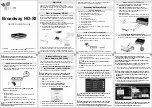
QuickMedia™ Receiver/Processor Crestron
QM-RMCRX-BA
Detail View of COM Port A (COM Port B is Identical)
COM Port Signals
SIGNAL TYPE
AND NAME
DESCRIPTION
Optional serial input
<
tx$
>
Transmits the corresponding serial data out of the COM port.
Optional serial output
<
rx$
>
Receives serial data from the COM port.
Optional digital input
<
enable
>
Enables the "Serial I/O" functions of the serial driver for as long as the input is high.
High/1 (level sensitive) = Enable Serial I/O
Low/0 = Disable Serial I/O
Optional digital input
<
break
>
Generates a break on the rising edge of the input. The break is a string of zeros with
a length of 17 to 20 bits.
High/1 (rising edge) = Break
Low/0 = No effect
Optional digital input
<
rts
>
Activates the RTS (Request to Send) pin on the COM port, for as long as the input is
high.
If this signal is used, then the "Hardware Handshaking" option must be set to "None"
in the Device Settings. Normally this signal would not be used, and a "Hardware
Handshaking" option would be selected in the Device Settings to handle the RTS pin.
High/1 (level sensitive) = Activate RTS pin
Low/0 = Release RTS pin
Optional digital output
<
cts
>
Indicates that the CTS (Clear to Send) pin on the COM port has been activated. The
output remains high for as long as the CTS pin is activated.
If this signal is used, then the "Hardware Handshaking" option must be set to "None"
in the Device Settings. Normally this signal would not be used (If RTS/CTS is
selected in the "Hardware Handshaking" options, this signal will not be driven).
High/1 = CTS pin activated
Low/0 = CTS pin released
Continued on the following page
44
•
QuickMedia™ Receiver/Processor: QM-RMCRX-BA
Operations Guide - DOC. 6332
















































